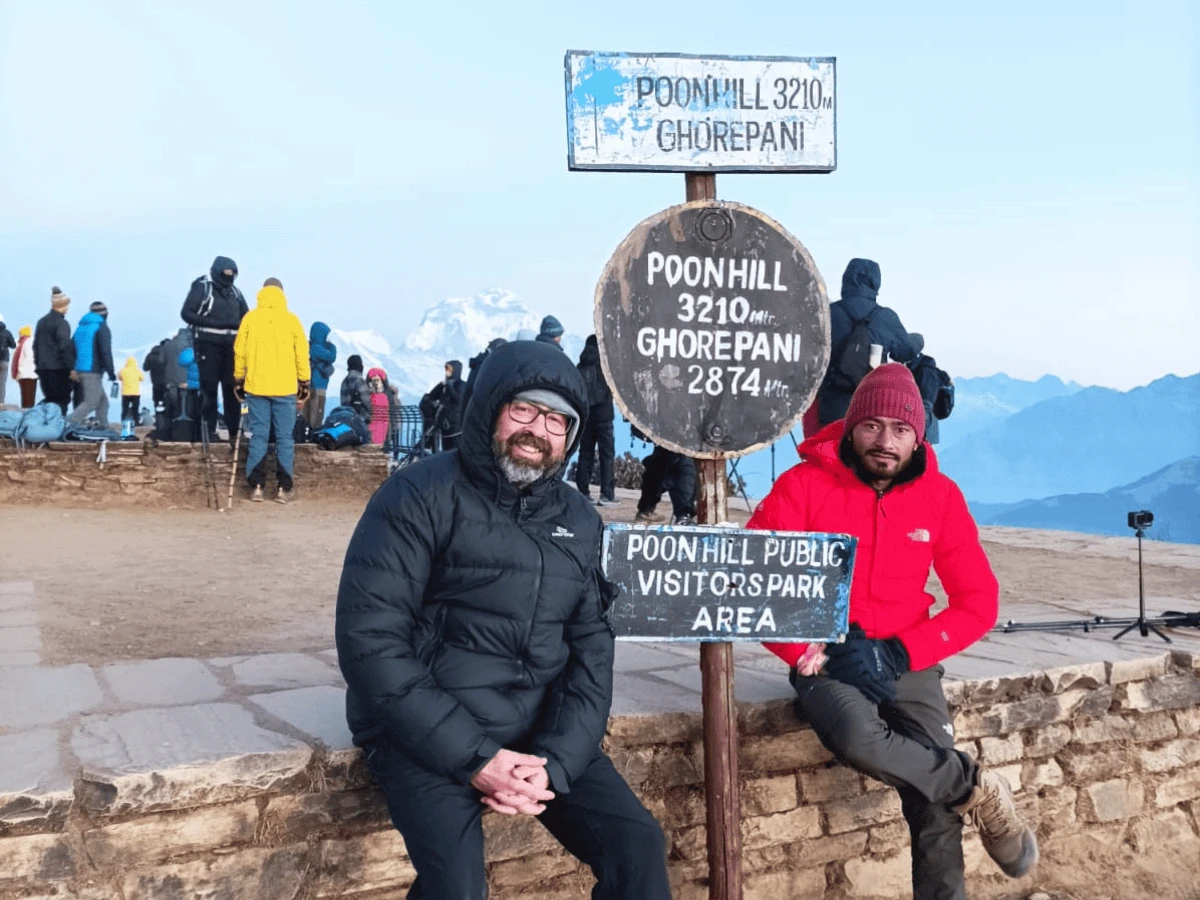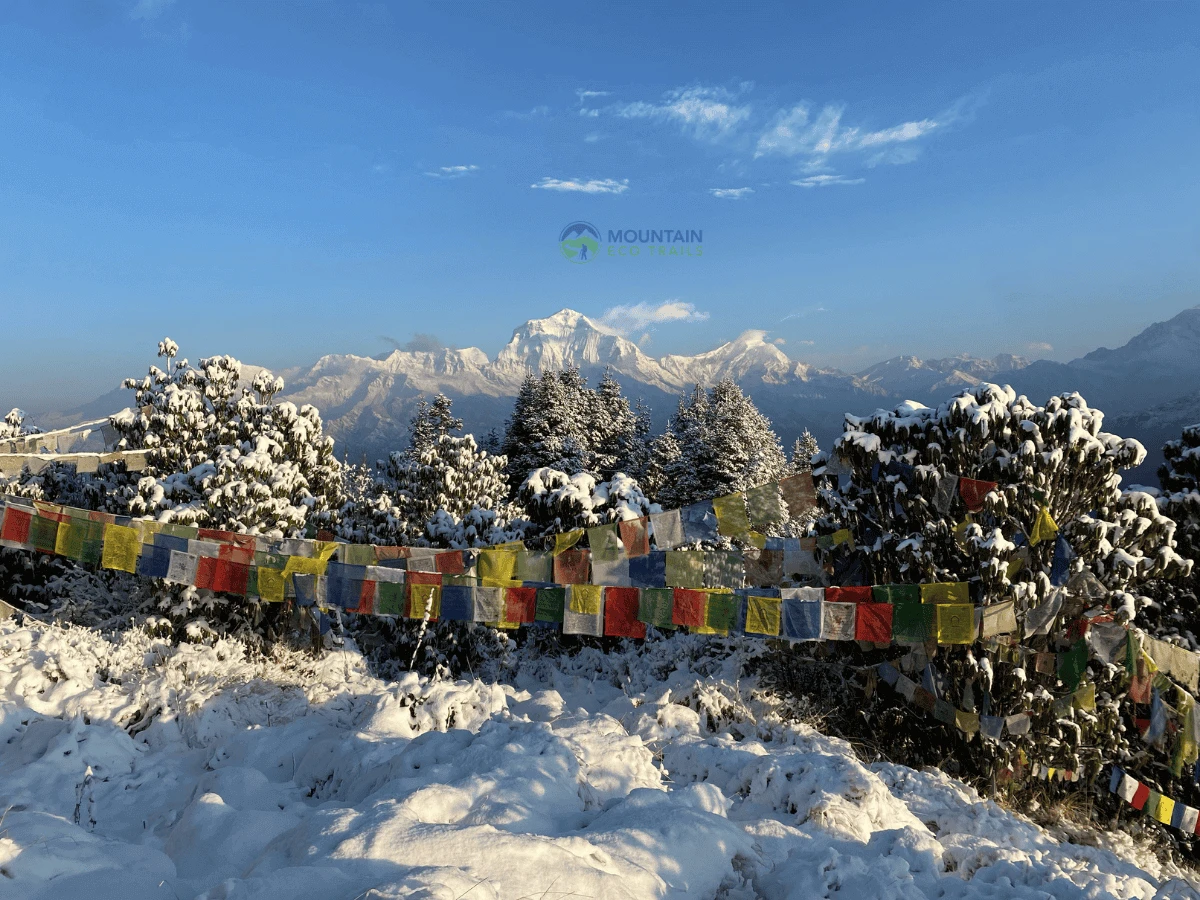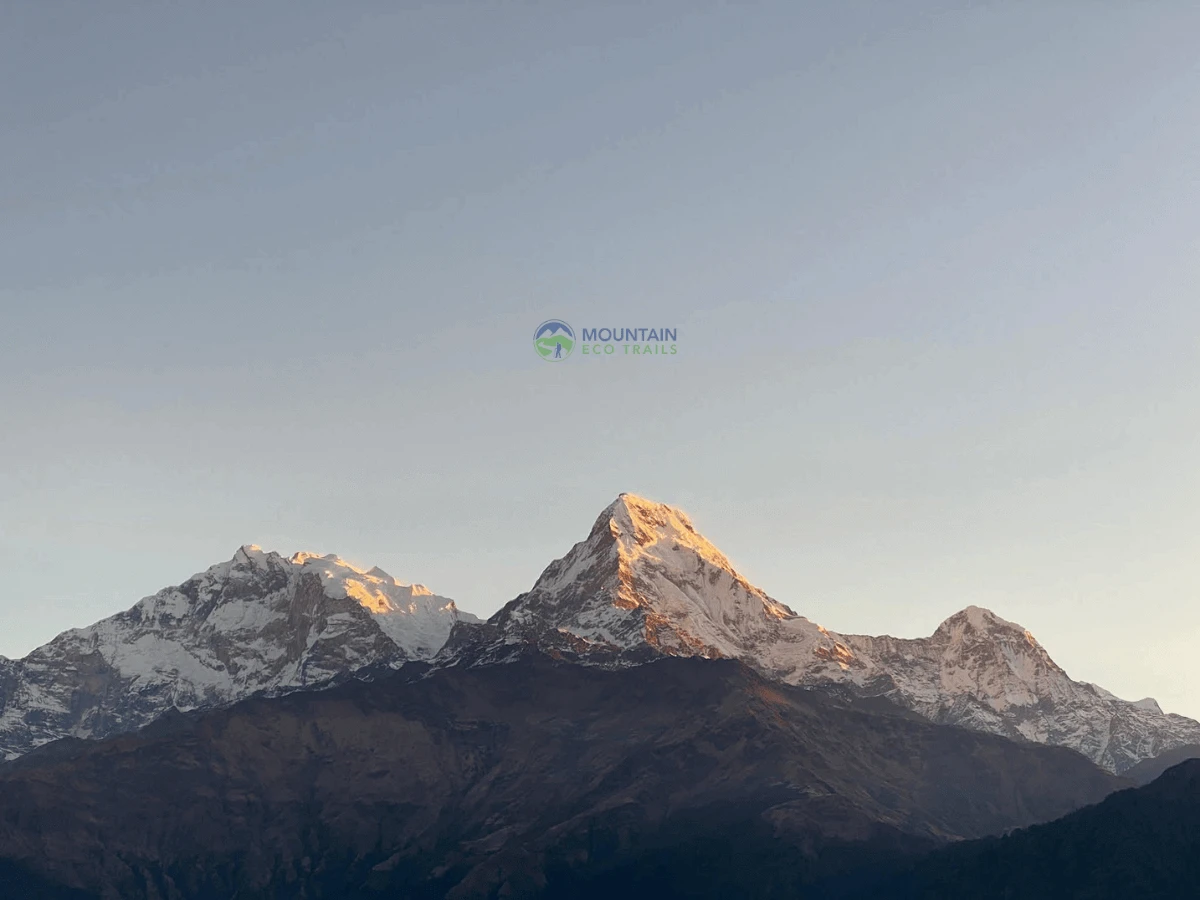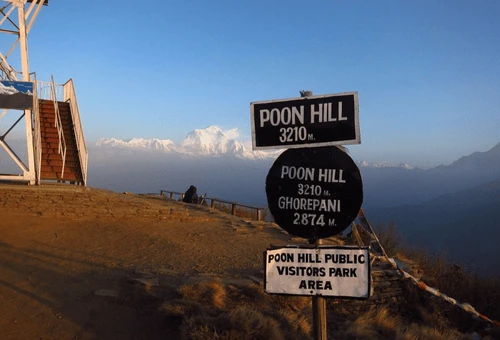The Poon Hill Trek is a spectacular short trek in Nepal that packs the best of the Himalayas into just four days. Starting and ending in Pokhara, this sunrise trek from Pokhara leads you through charming villages and lush rhododendron forests to the famous Poon Hill viewpoint (3,210m)
From the summit of Poon Hill, you’ll witness an awe-inspiring sunrise over the Annapurna and Dhaulagiri ranges – a panoramic 360° view of snow-capped giants including Annapurna I (8,091m) and Dhaulagiri (8,167m). Often known as the Ghorepani Poon Hill Trek, this route is renowned for its natural beauty, cultural richness, and accessibility, making it an ideal adventure for trekkers with limited time.
Over four memorable days, you’ll trek through terraced rice fields, cross sparkling streams, and stay in welcoming teahouse lodges run by local Gurung and Magar families. The trail’s moderate altitude and well-maintained paths mean you can fully enjoy the journey without extreme exertion. Despite being a short Poon Hill trek, it offers an immersive Himalayan experience – from warm village hospitality to up-close vistas of iconic peaks.
Short and Easy Trek in Nepal
If you’re seeking the best short trek in Nepal that is beginner-friendly, the Poon Hill Trek is hard to beat. It is often praised as one of Nepal’s gentler trekking routes, perfect for families and first-time trekkers. The trail itself is well-marked and maintained, with a gradual ascent spread over two days and a gentle descent thereafter. This means trekkers of almost any age or fitness level can complete the trek without difficulty, provided they can walk for a few hours each day.
What makes Poon Hill a short and easy trek in Nepal is its comfortable pace and good infrastructure. You’ll typically hike 4–6 hours each day over moderate terrain. The most challenging section is the long stone staircase to Ulleri, but taken slowly, it’s manageable even for beginners.
In summary, the Ghorepani Poon Hill Trek offers high rewards for modest effort: you get the sweeping Himalayan panoramas and cultural insights of a longer trek, condensed into a short trek in Nepal that’s accessible and enjoyable for novice trekkers.
Why 4-day Poon Hill the Best Short Trek from Pokhara?
Poon Hill is often hailed as the best short trek in Nepal – and for good reason. Here are some key reasons why this 4-day trek from Pokhara stands out among other short adventures:
Spectacular Sunrise Panorama: Nowhere else on a short trek can you so easily reach a viewpoint like Poon Hill, which offers a 360° panorama of Himalayan peaks at sunrise The combination of convenience and WOW-factor is unparalleled.
Short Duration, Big Rewards: In just four days, you experience what many longer treks offer – mountain vistas, diverse landscapes, and cultural encounters. This efficiency makes it perfect for those with limited time who still want the full Himalayan trek experience.
Easy Accessibility: The trek begins a short drive from Pokhara, Nepal’s adventure hub. No domestic flights are required to reach the trailhead (unlike Everest treks). You can start this trek the day after you arrive in Pokhara. Its accessibility also means if needed, help or amenities are never far away.
Moderate Difficulty – Great for Beginners: Poon Hill is widely regarded as Nepal’s best introductory trek. It’s short and easy enough for beginners or family groups, yet still provides the sense of accomplishment of trekking in the Himalayas. The lower altitude and established trails make it a safe, low-risk adventure for trekkers of all ages.
Cultural Experience: Along the way, you’ll stay in Gurung and Magar villages like Ghorepani and Ghandruk. This trek gives you a taste of local mountain culture – from traditional houses and folk museums to the warm hospitality of teahouse owners. You might witness ethnic dances or try on traditional dress in Ghandruk’s museum. It’s a wonderful blend of nature and culture.
Budget-Friendly Trek in Nepal: Poon Hill is a budget-friendly trek in Nepal due to its short length and the abundance of lodges (which keeps costs competitive). No expensive gear or permits beyond the basics are needed. Travellers often note that the Poon Hill Trek 4-day cost is very reasonable compared to longer treks, making it accessible to students and budget travellers. (See “Poon Hill Trek cost” below for details on pricing.)
All these factors combine to make Poon Hill the best short trek from Pokhara. It’s a trek that fits easily into a Nepal itinerary, is kind to your wallet, and yet leaves you with lifelong memories of Himalayan sunrises and friendly villages. Whether you’re new to trekking or a seasoned hiker looking for a mellow excursion, Poon Hill delivers an outstanding experience.
Poon Hill Sunrise Experience
The pre-dawn hike to Poon Hill is the crown jewel of this trek – a once-in-a-lifetime sunrise experience that justifies every step of the journey. Early on Day 3, you’ll wake in the village of Ghorepani and set out with headlamps under the stars. After about an hour of uphill hiking, you reach Poon Hill in time for dawn.
As the first light breaks, you’ll watch the sun rising above the Himalayan horizon, painting the sky in hues of orange and gold. One by one, the peaks begin to glow. The golden rays of the sun striking the faces of Dhaulagiri, Annapurna South, Machhapuchhre (Fishtail), and other surrounding peaks are a breathtaking sight. Trekkers often enjoy a cup of hot tea or coffee at the top, savouring the moment as the mountains light up.
This Poon Hill sunrise trek is rightly famous; the viewpoint offers one of the most accessible panoramic vistas in Nepal. On clear mornings, you can see a long sweep of the Himalayas, including Annapurna I (8,091m), Annapurna South (7,219m), Hiunchuli, Machhapuchhre (6,993m), and the entire Dhaulagiri massif.
Poon Hill Trek Difficulty: How Hard is This 4-Day Trail?
How hard is the Poon Hill Trek? In truth, it’s considered an easy-to-moderate trek by Himalayan standards. This 4-day trail does not venture into extreme altitudes or remote wilderness, which contributes to its reputation as one of the easiest multi-day treks in the Annapurna region.
The highest point is Poon Hill at 3,210m, reached during a short pre-dawn hike. This elevation is below the usual threshold (around 3,500m) where serious altitude issues typically begin, so most trekkers handle it well. Additionally, the trek route allows for gradual acclimatisation: you’ll climb over two days, giving your body time to adjust naturally to the thinner air.
The trail itself is well-trodden and mostly straightforward. As noted, the most strenuous portion is the ascent to Ulleri on Day 1, involving roughly 3,300 stone steps up from the valley floor. This can be tiring, but you can tackle it at your own pace with plenty of short breaks. Beyond Ulleri, the inclines are more gradual. Day 2 to Ghorepani is a gentler uphill through forests, and after the sunrise hike on Day 3, much of the remaining route is downhill or rolling terrain. Trekkers typically cover about 8–12 km per day (5–7 miles), which translates to 4-6 hours of walking with breaks. Good hiking shoes and a reasonable fitness level (ability to walk several hours with a light pack) are usually sufficient preparation.
Poon Hill Trek 4 Days Itinerary Overview
The Poon Hill Trek itinerary route map starts with a 1.5-hour drive from Pokhara to the trailhead at Nayapul (1,070m). Begin trekking through Birethanti and Hile, following a riverside path.
On the first day, tackle the famous Ulleri staircase – around 3,000 stone steps leading up to the Magar village of Ulleri at 2,070m. The next day, enjoy breakfast with a view of Annapurna South and Hiunchuli from Ulleri. The trail continues ascending gently through oak and rhododendron forests. Pass through villages like Banthanti and Nangethanti. After about 4–5 hours of hiking, arrive at Ghorepani (2,875m), a picturesque village surrounded by mountains.
Wake up before dawn (around 4:00 am) and hike for about an hour to Poon Hill (3,210m) with your flashlight to catch the sunrise. Take in the unforgettable sunrise over the Himalayas as golden light bathes the peaks of Dhaulagiri, Nilgiri, Annapurna I, and Machhapuchhre.
From Ghorepani, begin the trek towards Tadhapani. The path first climbs a ridge and then descends through forests via Deurali and Tadapani (2,600m). Savour a final morning in the mountains, with clear views of Annapurna South (7,219m) and Hiunchuli from Tadhapani. After breakfast, trek downhill through the forest to arrive at Ghandruk Village. Take a moment to stroll around Ghandruk after lunch and take a Jeep back to Pokhara to conclude the short trip.
4-Day Poon Hill Trek cost 2026,2027
Poon Hill Trek costs start from USD 399 to USD 600 per person, depending on the service you desire to have. Likewise, Mountain Eco Trails offers the Poon Hill Trek cost based on the timing of your booking, your group size, your itinerary, and the services you prefer.
Booking Your Poon Hill Trek with Mountain Eco Trails
When it comes to organising the Poon Hill trek, choosing the right trekking company can enhance your experience enormously. Mountain Eco Trails is a local Nepali trekking company (based in Kathmandu and Pokhara) that specialises in guided treks exactly like Poon Hill. Booking with a reputable outfitter like Mountain Eco Trails offers several advantages:
- Expert Planning and Support
- Knowledgeable Local Guides
- Eco-Friendly Ethos
- All-Inclusive Service, No Hidden Costs:
- Flexibility and Customisation
- Safety and Support:
- Local Insight and Cultural Exchange
To book with Mountain Eco Trails, you can contact us via our website or email. We usually require a deposit to secure your spot and begin arrangements, with the balance payable upon arrival. It’s recommended to book at least a few weeks or months in advance, especially for peak season (Oct-Nov, Mar-Apr), to ensure availability of guides and any internal flights/hotels if needed.






